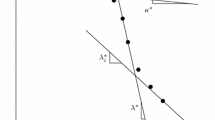In this paper, a new model of undisturbed loess was presented based on the modified Cam-clay model with the structural and anisotropic parameters. The associated flow rule, combined with the consistency condition, was used to derive the incremental stress-strain relationship and establish a new model. The new model has a total of eight parameters, which can be obtained through routine labor tests. A triaxial test was conducted by selecting natural undisturbed loess. A comparison between the experimental results and calculated results shows that the new model is better than the modified Cam-clay model in simulating the stress-strain characteristics of natural undisturbed loess.
Similar content being viewed by others
References
Z. Liu, F. Y. Liu, F. L. Ma, M. Wang, X. H. Bai, Y. L. Zheng, H. Yin, and G. P. Zhang, “Collapsibility, composition, and microstructure of loess in China,” Can. Geotech. J., 53(4), 673–686 (2016).
W. L. Xie, P. Li, M. S. Zhang, T. E. Cheng, and Y. Wang, “Collapse behavior and microstructural evolution of loess soils from the Loess Plateau of China,” J. Mount. Sci., 15(8), 1642–1657 (2018).
X. X. Shao, H. Y. Zhang, and Y. Tan, “Collapse behavior and microstructural alteration of remolded loess under graded wetting tests,” Eng. Geol., 233, 11-22 (2018).
C. Yang, Y. J. Cui, J. M. Pereira, and M. S. Huang, “A constitutive model for unsaturated cemented soils under cyclic loading,” Comput. Geotech. 35(1),853-859 (2008).
G. A. Akbari, S. M. Haeri, and C. S. Desai, “testing and constitutive modeling of lime-stabilized collapsible loess,” Int. J. Geomech., 19(4), 04019007 (2019).
Y. W. Zhang, Z. P. Song, X. L. Weng, and Y. L. Xie, “A new soil-water characteristic curve model for unsaturated loess based on wetting-induced pore deformation,” Geofluids, 1672418, 14 (2019)
M. D. Liu, J. P. Carter, and C. S. Desai, “Modeling compression behavior of structured geomaterials,” Int. J. Geomech., 3(2),191-204 (2003)
E. Y. Zhu and Y. P. Yao, “Structured UH model for clays,” Transp. Geotech., 3, 68-79(2015).
O. Ahad, “Disturbed state concept–based constitutive model for structured soils,” Int. J. Geomech. 17(7), 1-10 (2017).
E. L. Liu, H. S. Yu, C. Zhou, Q. Nie, and K. T. Luo, “A binary-medium constitutive model for artificially structured soils based on the disturbed state concept and homogenization theory,” Int. J. Geomech., 17(7), 04016154(2017).
S. L. Chen and K. Liu, “Undrained cylindrical cavity expansion in anisotropic critical state soils,” Geotechnique, 69(3), 189-202 (2019)
S. J. Wheeler, A. Naatanen, M. Karstunen, and M. Lojander, “An anisotropic elastoplastic model for soft clays,” Can. Geotech. J., 40, 403-418 (2003).
J. Castro and N. Sivasithamparam, “A constitutive model for soft clays incorporating elastic and plastic crossanisotropy,” Materials, 10(6), 584 (2017).
Y. F. Dafalias, “An anisotropic critical state soil plasticity model,” Mech. Res. Commun., 13(6), 341-347 (1986).
P. K. Banerjee and N. B. Yousif, “A Plasticity model for the mechanical-behavior of anisotropically consolidated clay,” Int. J. Numer. Anal. Methods Geomech., 10 (5), 521-541 (1986).
N. Sivasithamparam and J. Castro, “An anisotropic elastoplastic model for soft clays based on logarithmic contractancy,” Int. J. Numer. Anal. Methods Geomech., 40, 596–621 (2016).
K. H. Roscoe, A. N. Schofield, and A. Thurairajah, “Yielding of clays in states wetter than critical,” Geotechnique, 13(3), 211-240 (1963).
X. Du, X. Cheng, and M. Gao, “Determination of the parameters of Modified Cam-Clay model for paddy grain,” J. Cereal Sci., 76, 1-7 (2017).
Y. P. Yao and A. N. Zhou, “Non-isothermal unified hardening model: a thermo-elastoplastic model for clays,” Geotechnique, 63(15), 1328–1345 (2013).
C. Zhou and C. W. W. Ng, “A new thermo-mechanical model for structured soil,” Geotechnique, 68(12), 1109-1115 (2018)
F. Tavenas, P. Jean, P. Leblond, and S. Leroueil, “The permeability of natural soft clays. Part II: Permeability characteristics,” Can. Geotech. J., 20(4), 645–660 (1983).
H. Tanaka and J. Locat, “A microstructural investigation of Osaka Bay clay: The impact of microfossils on its mechanical behavior,” Can. Geotech. J., 36(3), 493–508 (1999).
Author information
Authors and Affiliations
Corresponding author
Additional information
Translated from Osnovaniya, Fundamenty i Mekhanika Gruntov, No. 1, January-February, 2022.
Rights and permissions
About this article
Cite this article
Zhang, Y., Song, Z. & Weng, X. A Constitutive Model for Loess Considering the Characteristics of Structurality and Anisotropy. Soil Mech Found Eng 59, 32–43 (2022). https://doi.org/10.1007/s11204-022-09781-z
Published:
Issue Date:
DOI: https://doi.org/10.1007/s11204-022-09781-z




